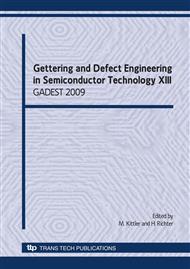p.107
p.115
p.123
p.129
p.135
p.139
p.145
p.149
p.155
Low-Temperature Elastic Softening due to Vacancies in Boron-Doped FZ Silicon Crystals
Abstract:
We confirm the following findings obtained in our previous experiment for the low-temperature elastic softening by the vacancies in boron-doped silicon crystals: (1) the steep softening that suddenly starts at 2-4 K in the cooling process, and (2) the complete disappearance of the softening by a weak magnetic field of 4 T applied along [111] direction. We further investigate in detail how the low-temperature softening at a fixed temperature responds to the applied magnetic field, to find the following characteristic anisotropy: The manner of disappearance of the softening strongly depends on the direction of the magnetic field. For the magnetic field imposed along [1-10] direction, nearly 60 % of the full softening still remains even at a strong magnetic field of 8 T, in contrast to the case of magnetic field applied along [111] direction.
Info:
Periodical:
Pages:
135-138
Citation:
Online since:
October 2009
Keywords:
Price:
Сopyright:
© 2010 Trans Tech Publications Ltd. All Rights Reserved
Share:
Citation:


